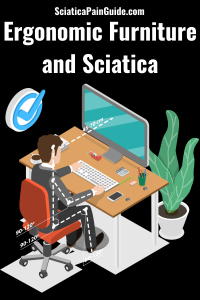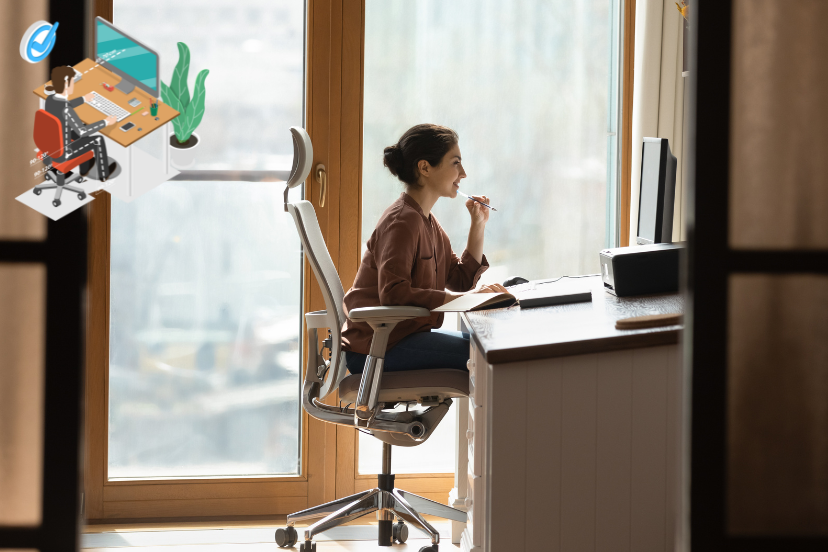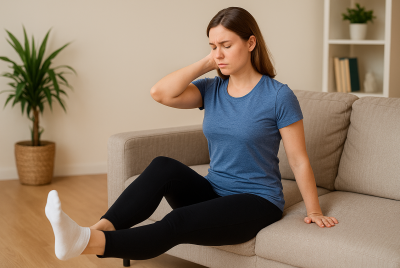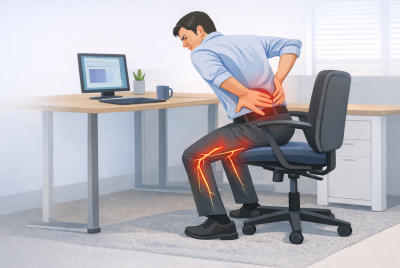Ergonomic Furniture and Sciatica
A Guide to Relieving Pain Through Better Furniture Choices
Discover what to ergonomic furniture and sciatica pain. Learn the best furniture choices and tips for a pain-free, comfortable setup! If you’re dealing with the nagging pain of sciatica, you probably know how challenging it can be to stay comfortable during the day. Sciatica is not just an ordinary back pain; it’s a deeper, more frustrating experience that can affect every aspect of your life. That’s where ergonomic furniture comes in! In this guide, I’ll walk you through why ergonomic furniture matters, what to look for, and how it can make a difference in managing sciatica pain.
What is Sciatica?
Sciatica refers to pain that radiates along the sciatic nerve, which extends from your lower back down each leg. Sciatica pain usually affects only one side of your body and can range from mild to severe. The pain might be sharp, burning, or even cause a tingling sensation down your leg.
Why Ergonomic Furniture Matters for Sciatica Sufferers
When it comes to sciatica, traditional furniture often fails to provide the necessary support. Ergonomic furniture, designed to adapt to your body’s needs, helps relieve the strain on your spine and sciatic nerve. By investing in ergonomic solutions, you can create a setup that minimizes pressure on sensitive areas and promotes a healthier posture.
Understanding Sciatica Pain and Triggers
Causes of Sciatica Pain
Sciatica pain is often triggered by compression of the sciatic nerve due to herniated discs, spinal stenosis, or bone spurs. Poor posture, prolonged sitting, or awkward seating arrangements can further aggravate the pain.
The Impact of Poor Posture on Sciatica
Sitting in an unsupportive chair for extended periods can increase pressure on your lower back, intensifying sciatica symptoms. By using ergonomic furniture designed for spinal support, you can alleviate some of these triggers and lessen the impact of your daily routine on your sciatica pain.
What is Ergonomic Furniture?
Defining Ergonomics and Its Benefits for Sciatica
Ergonomic furniture is designed with human anatomy in mind. It adapts to your unique shape, providing support exactly where you need it most. For sciatica sufferers, this means less strain on the lower back and improved comfort overall.
How Ergonomic Furniture Can Help with Sciatica Relief
Ergonomic furniture helps keep the spine aligned and reduces strain on the sciatic nerve by offering support where it’s needed most. Adjustable features, lumbar support, and comfortable materials work together to make sitting or standing more comfortable and sustainable for those with sciatica.
Key Features to Look for in Ergonomic Furniture
Adjustable Height
Having a chair or desk with adjustable height lets you set up your workspace in a way that keeps your spine aligned. Height adjustments are crucial for making sure your feet rest flat on the floor while your arms are parallel to the desk.
Lumbar Support
Good lumbar support is essential for sciatica sufferers. Ergonomic chairs with adjustable lumbar support help maintain the natural curve of your spine, preventing additional stress on the lower back.
Seat Depth and Cushioning
A seat that’s too deep can pressure the back of your thighs and worsen sciatica pain. Look for ergonomic chairs with adjustable seat depth and cushioning that distributes weight evenly across your lower body.
Armrest Adjustability
Adjustable armrests allow you to keep your arms supported without straining your shoulders or back. By setting them to the right height, you can maintain a relaxed position that won’t put extra pressure on your spine.
Material and Build Quality
High-quality materials like memory foam cushions or breathable mesh backs provide comfort and durability. Investing in well-made ergonomic furniture will ensure you get the support you need for years to come.
Ergonomic Chairs: Your Best Bet for Sciatica Relief
Why an Ergonomic Chair?
Ergonomic chairs are designed specifically to support a healthy posture, reducing strain on the spine and minimizing sciatica pain. They typically offer adjustments for height, back angle, and lumbar support, providing a personalized seating experience.
Recommended Ergonomic Chair Types for Sciatica
Look for options like saddle chairs or kneeling chairs, which promote good posture by aligning your spine and reducing pressure on the lower back. High-back chairs with adjustable lumbar support are also excellent for sciatica relief.
5 Secrets to Make Your Office Chair Comfortable & Pain-Free
Ergonomic Desks for Sciatica Pain
Benefits of Standing Desks for Sciatica
Standing desks encourage movement throughout the day, which can relieve the pressure of prolonged sitting. Alternating between sitting and standing can alleviate sciatic pain by promoting blood flow and reducing nerve compression.
Adjustable Desks and Desk Converters
Adjustable desks allow you to switch from sitting to standing quickly, which can reduce sciatica flare-ups. Desk converters are also an affordable way to achieve a similar setup without replacing your existing desk.
Additional Ergonomic Accessories for Sciatica Relief
Footrests for Posture Support
A footrest can be a game-changer. It keeps your feet flat and your knees at a comfortable angle, reducing strain on your lower back.
Cushions for Extra Comfort
Seat cushions with memory foam or gel can provide extra padding, especially if you have to sit for long hours. Coccyx cushions are particularly helpful as they relieve pressure on your tailbone.
Monitor Stands and Laptop Risers
By elevating your monitor to eye level, you can avoid hunching over, which helps maintain a better posture and reduces strain on your back and neck.
What’s the Best Posture for Sciatica Relief
The best posture for sciatica relief is one that minimizes pressure on the lower back and keeps your spine aligned. Here are a few tips:
Sit with Your Feet Flat: Keep your feet flat on the floor or on a footrest, with your knees at a 90-degree angle.
Support Your Lower Back: Use a chair with good lumbar support or add a cushion behind your lower back to maintain the natural curve of your spine.
Keep Hips and Knees Aligned: Aim to keep your hips slightly above knee level, as this reduces strain on the lower back.
Avoid Slouching: Sit back in your chair with your shoulders relaxed and avoid leaning forward, which can add pressure to the sciatic nerve.
Adjusting your workspace to maintain this posture and taking regular breaks to move around can help reduce sciatica pain throughout the day.
Tips for Using Ergonomic Furniture Effectively
Adjusting Your Setup for Maximum Benefit
Make sure to adjust your chair, desk, and monitor height to maintain an ergonomic setup. Your feet should be flat, your thighs parallel to the floor, and your screen at eye level.
Combining Ergonomic Furniture with Good Habits
Remember, no piece of furniture alone can completely eliminate sciatica pain. Pair your ergonomic setup with good habits, such as taking breaks, stretching, and practicing core-strengthening exercises to improve your posture over time.
Are there any Specific Ergonomic Brands Recommended for Sciatica Relief
Several ergonomic brands are popular for sciatica relief. Brands like Herman Miller, Steelcase, and Secretlab offer chairs with adjustable lumbar support and customizable features that enhance comfort. These brands focus on high-quality ergonomic designs, providing options specifically made to alleviate lower back strain and promote better posture.
FAQs Related to Ergonomic Furniture and Sciatica
How quickly can I expect relief from sciatica pain after switching to ergonomic furniture?
It varies, but some people notice improvement within a week as their posture adjusts to better support.
How do I know if a chair or desk is truly ergonomic?
Look for features like adjustable height, lumbar support, and seat depth. Also, check for durability and material quality.
How does ergonomic furniture help relieve sciatica pain?
Ergonomic furniture supports the natural alignment of your spine, reducing pressure on the lower back and sciatic nerve, which can help alleviate pain.
Is a standing desk better for sciatica than a regular desk?
Yes, standing desks can ease sciatic pain by allowing you to alternate between sitting and standing, reducing prolonged pressure on the lower back.
What should I look for in an ergonomic chair if I have sciatica?
Look for adjustable lumbar support, seat depth, height, and armrests to maintain a comfortable, spine-friendly posture that minimizes sciatica pain.
Can I use ergonomic furniture if I don’t suffer from sciatica?
Yes, absolutely! Ergonomic furniture benefits everyone, not just those with sciatica. It promotes better posture, reduces strain on the back and neck, and increases overall comfort. By supporting your body’s natural alignment, ergonomic furniture helps prevent issues like muscle fatigue, stiffness, and even future back problems. So, even if you’re not dealing with sciatica, ergonomic furniture can still make a big difference in your comfort and well-being!
Are ergonomic chairs enough to relieve sciatica pain completely?
While ergonomic chairs help significantly, complete relief also requires proper posture, regular movement, and exercises to support spinal health.
Ergonomic Furniture and Sciatica – Conclusion
Investing in ergonomic furniture can truly transform the experience of living with sciatica. By selecting furniture designed to support your body and using it effectively, you’re taking a proactive step toward managing your pain and improving your quality of life. Remember to adjust your furniture, take breaks, and practice good posture habits to get the most out of your ergonomic setup.
Disclaimer
Please note that this article should not replace professional medical advice. Consult a healthcare professional for an accurate diagnosis and tailored treatment plan.






